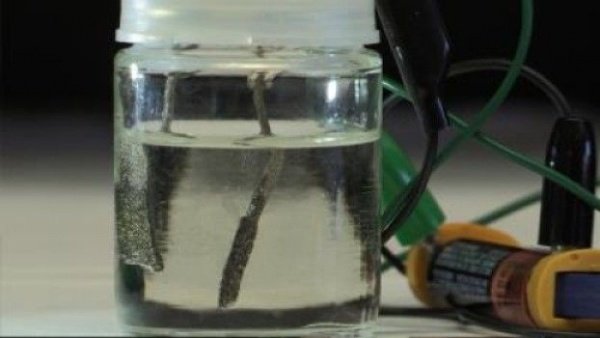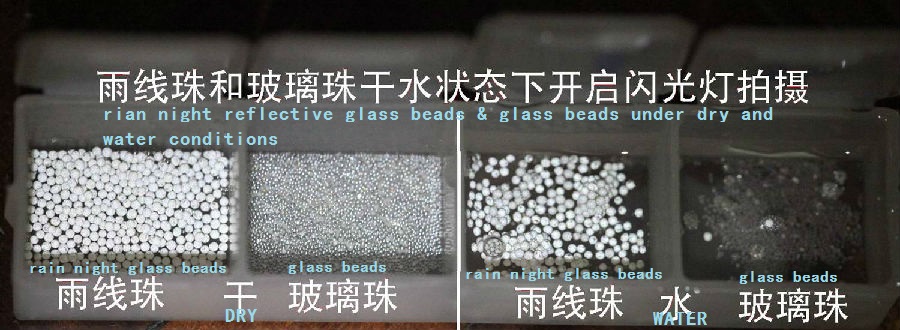Science Daily reported that Hongjie Dai, a professor of chemistry at Stanford University in the United States, and colleagues recently developed a cheap, zero-emission electrolytic device that uses a 1.5-volt battery to decompose water into hydrogen and oxygen at room temperature. In 2015, American consumers will be able to purchase fuel cell vehicles from Toyota and other manufacturers in Japan. Although known as a zero-emission vehicle, most vehicles use natural gas. Natural gas, a fossil fuel, will cause global warming.

As long as a common AAA battery is used, hydrogen can be generated by water electrolysis.
Now scientists at Stanford University have developed low-cost, zero-emission equipment that uses only a common AAA battery to produce hydrogen through water electrolysis. The battery sends current through both electrodes, causing the water to decompose into hydrogen and oxygen. Unlike other water electrolyzers that make use of precious metal catalysts, the electrode of this latest device is made of nickel and iron, which are inexpensive and exist in large quantities.
"Using cheap nickel and iron, we are able to make the electrocatalyst sufficiently active to decompose water using a 1.5-volt battery at room temperature," said Professor Dai Hongjie. “This is the first time that water is decomposed at low voltage using an unprecious metal catalyst. This is incredible, because expensive metals such as platinum and rhodium are generally required to obtain such a low voltage.â€
In addition to generating hydrogen, the new water separator can also be used to make chlorine and sodium hydroxide, an important industrial chemical. Professor Dai and colleagues published these latest inventions in the August 22nd issue of Nature Communications.
Automotive manufacturers have long believed that hydrogen fuel is a very promising alternative to future gasoline engines. Fuel cell technology is essentially a reversed water decomposition. A fuel cell combines stored hydrogen and oxygen in the air to produce electricity to drive the car. The only by-product is water - this is different from gasoline burning, which produces greenhouse gas carbon dioxide.
Earlier this year, Hyundai Group began selling fuel cell vehicles in Southern California. Japan’s Toyota and Honda Motors will also begin selling fuel cell vehicles in 2015. Most cars will use fuels manufactured in large industrial plants that generate hydrogen through the combination of very hot steam and natural gas. This energy-intensive process Carbon dioxide is released as a by-product.
Decomposing water to make hydrogen does not require fossil fuels, nor does it release greenhouse gases. But scientists have not yet developed viable, active water separators and catalysts that can be used on an industrial scale. "This is the goal that has been pursued for decades to produce low-cost, highly active and long-lasting electrocatalysts. When we found that nickel-based catalysts were as effective as platinum, this was totally unexpected."
This catalyst was discovered by research co-author Cheng Gong graduate student Gong Gong. "Clearly, a nickel metal/nickel oxygen structure has been discovered. It is more active than pure nickel metal or pure nickel oxygen." Professor Dai said "This novel structure supports hydrogen electrocatalysis, but we still cannot fully understand the science behind it." ."
This nickel/nickel oxygen catalyst greatly reduces the voltage required to decompose water, which will ultimately save hydrogen manufacturers billions of dollars in electricity costs, Gong explained. His next goal is to increase the durability of this device. "The electrodes are relatively stable, but they will still slowly decay with time. Based on my recent results, this goal is achievable."
The researchers also plan to develop a solar-powered electrically-driven hydrolyzer. "Hydrogen is the ideal fuel for driving renewable energy in vehicles, buildings and storage grids," said Professor Dai. “We are very fortunate to be able to create an active and low-cost catalyst. This shows that through the nano-engineering of materials we can change the way fuels are produced and consumed.â€
All-Weather Rain Night Reflective Glass Beads,is a new concept of retroreflective materials. rain night glass beads can greatly inrove the security level of road markings , overcome the defects of traditional markings. its reflectivity is excellent no matter during the day or in rainy nights, which helps to make sure vehicles in line to ensure driver's safety. all weather reflective glass beads is the updated version of ordinary glass beads, it's ideal beads for highways, mountains high ways, uban roads, taxiways, runways and airfields. it's suitable for thermolastic hot-molt coating , water borne paint etc.
All Weather High Reflective Glass Bead/Rainy night glass beads:(Special Glass Beads For Raining Night Road Marking)Normal grade glass beads like 1.5 index works well and it has good reflective result in the nigh time without raining. But in Wet Raining Night, it will be dark.
Application:
(1) Hot-Melt Coating
(2) Double Component Coating
(3) Water Borne Paint
Characteristics :
(1) High Reflective Index in Wet Raining Night
(2) High Retro-reflective more than 350mcd while Durability Of Retro-reflective is more than 150mcd after 1 year
(3) Appearance: All Colors Available: Green, Blue, Red, Yellow, Silver, White
(4) Retro-Reflective index is 350 in dry condition and more than 250mcd in wet raining night.
(5) Gravity: 2.4-2.5g/cm3
(6) Road Marking Line Consumption per Square Meter: 180grams (half of 1.5 index glass beads)
(7) Chemical Composition: TiO2 BaO SiO2 ZrO2

All-weather Rain Night Reflective Glass Beads
All-Weather Rain Night Reflective Glass Beads,Wet Night Reflective Glass Beads,Rainy Night Reflective Glass Beads,High Reflective Night Reflective Glass Beads
YONGQING BAILUYUAN GLASS PRODUCTS CO.,LTD , https://www.blyglassbeads.com